Leadership and Management Report: P&G, Theories and Practices
VerifiedAdded on 2020/12/29
|11
|3366
|423
Report
AI Summary
This report delves into the core concepts of leadership and management, using Procter & Gamble (P&G) as a case study. It begins by defining and comparing the roles and characteristics of leaders and managers, highlighting their distinct contributions to organizational success. The report then examines how leadership and management principles apply in various situational contexts, such as planning, problem analysis, and controlling. It further explores and applies different leadership theories and models, including situational leadership, systems leadership, and the contingency approach, evaluating their strengths and weaknesses within the context of P&G. Finally, the report analyzes the factors within the business environment, such as political, economic, social, technological, legal, and environmental factors (PESTLE analysis), that impact operational management and decision-making by leaders and managers at P&G, providing a comprehensive overview of leadership and management practices in a real-world business setting.
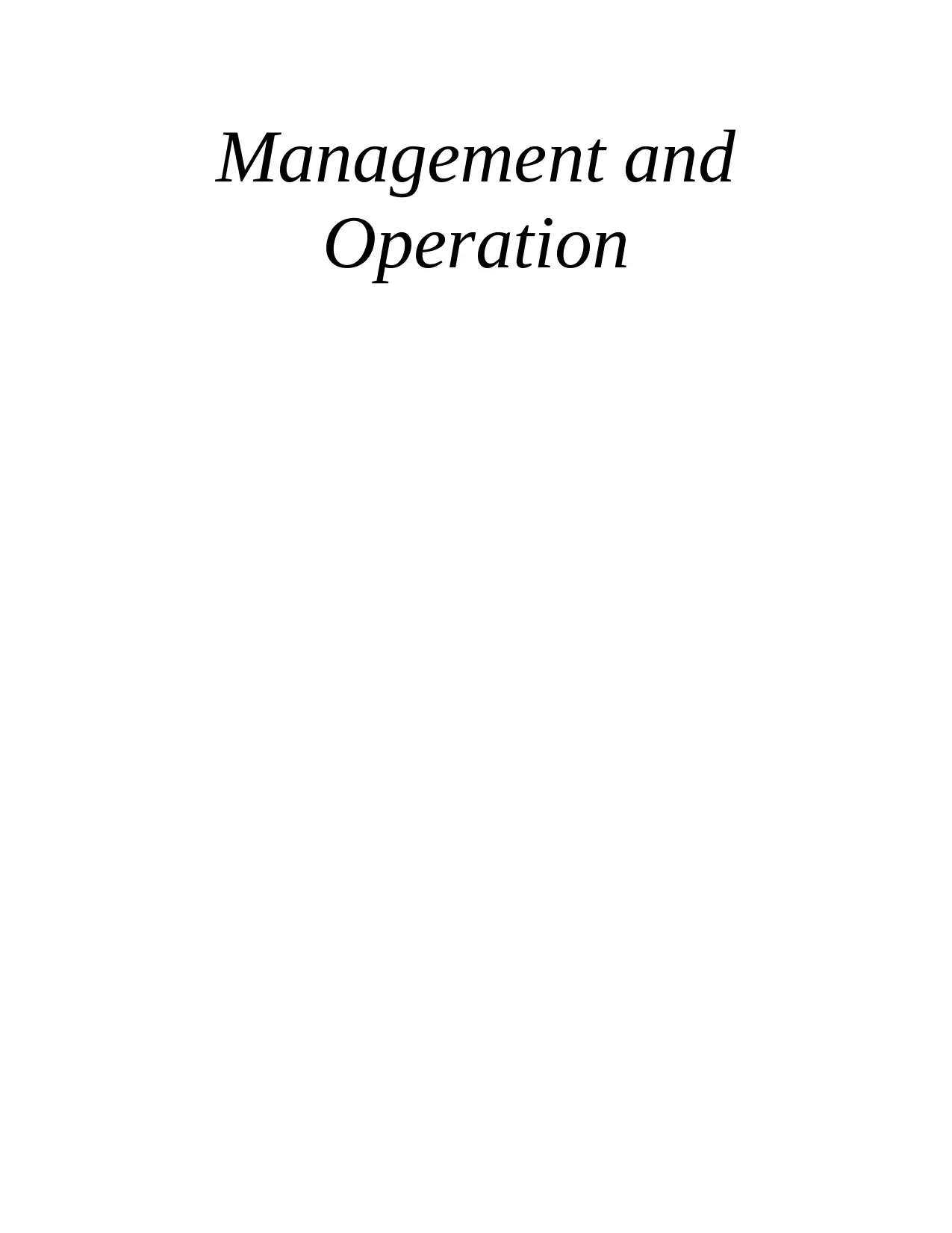
Management and
Operation
Operation
Paraphrase This Document
Need a fresh take? Get an instant paraphrase of this document with our AI Paraphraser
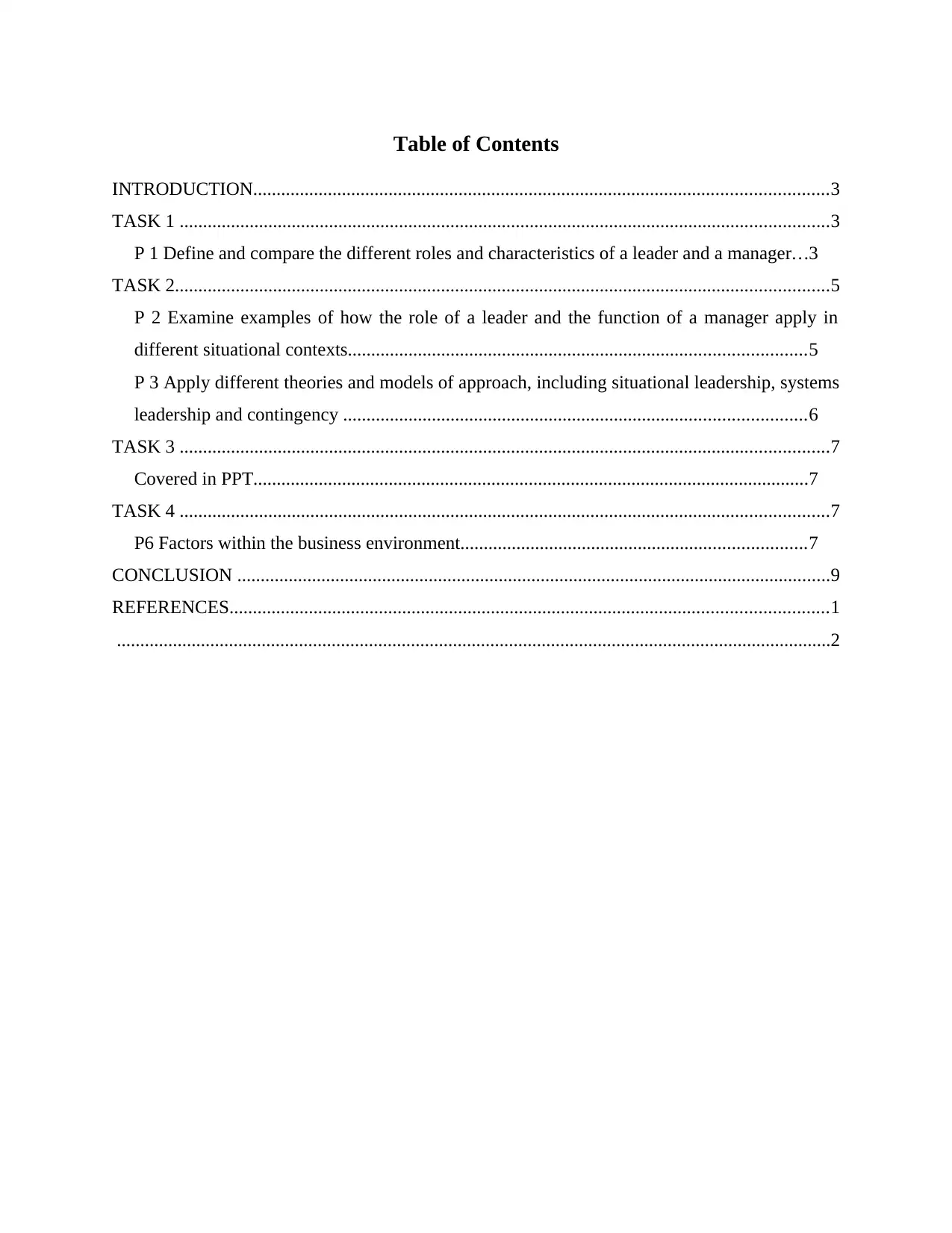
Table of Contents
INTRODUCTION...........................................................................................................................3
TASK 1 ...........................................................................................................................................3
P 1 Define and compare the different roles and characteristics of a leader and a manager...3
TASK 2............................................................................................................................................5
P 2 Examine examples of how the role of a leader and the function of a manager apply in
different situational contexts..................................................................................................5
P 3 Apply different theories and models of approach, including situational leadership, systems
leadership and contingency ...................................................................................................6
TASK 3 ...........................................................................................................................................7
Covered in PPT.......................................................................................................................7
TASK 4 ...........................................................................................................................................7
P6 Factors within the business environment..........................................................................7
CONCLUSION ...............................................................................................................................9
REFERENCES................................................................................................................................1
.........................................................................................................................................................2
INTRODUCTION...........................................................................................................................3
TASK 1 ...........................................................................................................................................3
P 1 Define and compare the different roles and characteristics of a leader and a manager...3
TASK 2............................................................................................................................................5
P 2 Examine examples of how the role of a leader and the function of a manager apply in
different situational contexts..................................................................................................5
P 3 Apply different theories and models of approach, including situational leadership, systems
leadership and contingency ...................................................................................................6
TASK 3 ...........................................................................................................................................7
Covered in PPT.......................................................................................................................7
TASK 4 ...........................................................................................................................................7
P6 Factors within the business environment..........................................................................7
CONCLUSION ...............................................................................................................................9
REFERENCES................................................................................................................................1
.........................................................................................................................................................2
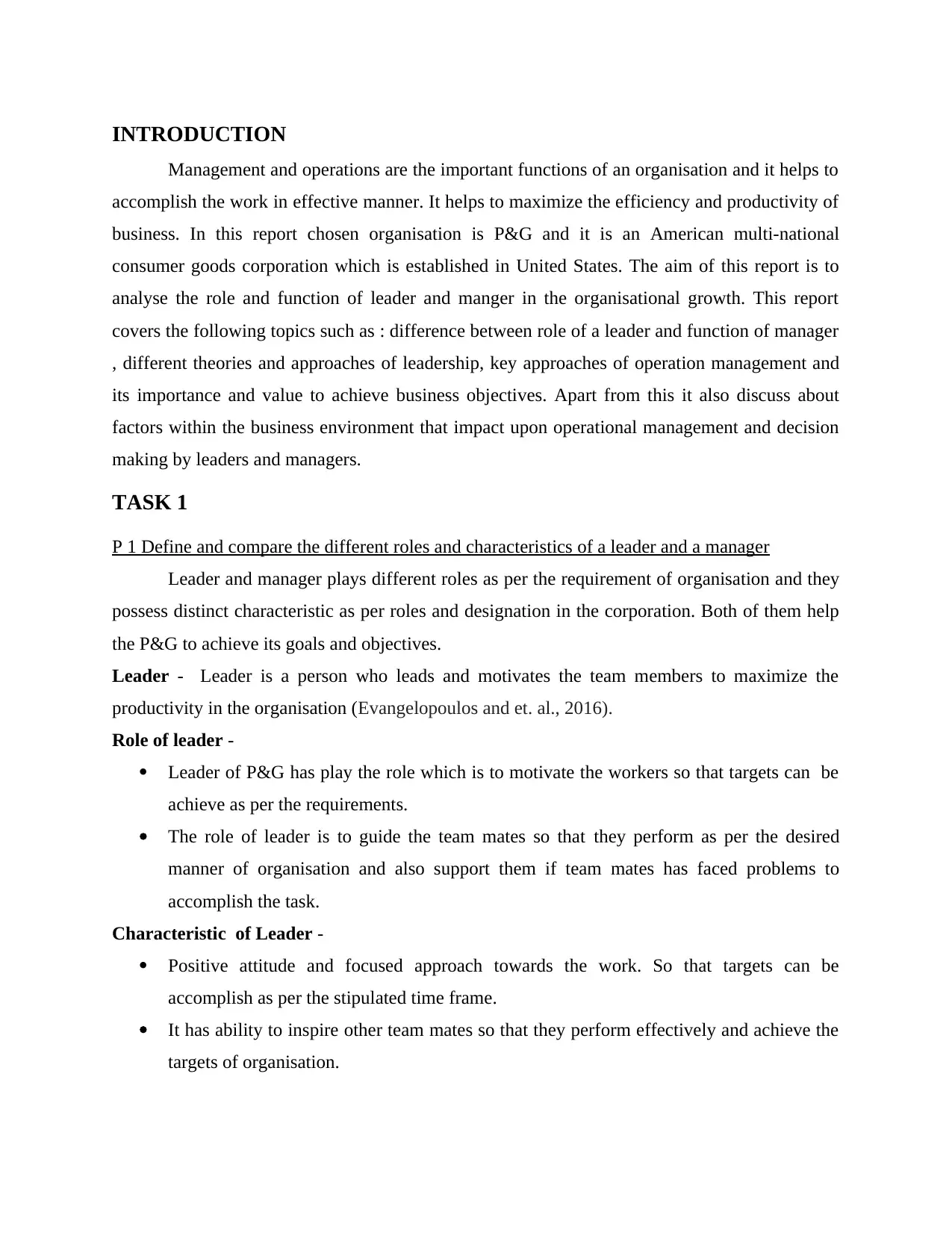
INTRODUCTION
Management and operations are the important functions of an organisation and it helps to
accomplish the work in effective manner. It helps to maximize the efficiency and productivity of
business. In this report chosen organisation is P&G and it is an American multi-national
consumer goods corporation which is established in United States. The aim of this report is to
analyse the role and function of leader and manger in the organisational growth. This report
covers the following topics such as : difference between role of a leader and function of manager
, different theories and approaches of leadership, key approaches of operation management and
its importance and value to achieve business objectives. Apart from this it also discuss about
factors within the business environment that impact upon operational management and decision
making by leaders and managers.
TASK 1
P 1 Define and compare the different roles and characteristics of a leader and a manager
Leader and manager plays different roles as per the requirement of organisation and they
possess distinct characteristic as per roles and designation in the corporation. Both of them help
the P&G to achieve its goals and objectives.
Leader - Leader is a person who leads and motivates the team members to maximize the
productivity in the organisation (Evangelopoulos and et. al., 2016).
Role of leader -
Leader of P&G has play the role which is to motivate the workers so that targets can be
achieve as per the requirements.
The role of leader is to guide the team mates so that they perform as per the desired
manner of organisation and also support them if team mates has faced problems to
accomplish the task.
Characteristic of Leader -
Positive attitude and focused approach towards the work. So that targets can be
accomplish as per the stipulated time frame.
It has ability to inspire other team mates so that they perform effectively and achieve the
targets of organisation.
Management and operations are the important functions of an organisation and it helps to
accomplish the work in effective manner. It helps to maximize the efficiency and productivity of
business. In this report chosen organisation is P&G and it is an American multi-national
consumer goods corporation which is established in United States. The aim of this report is to
analyse the role and function of leader and manger in the organisational growth. This report
covers the following topics such as : difference between role of a leader and function of manager
, different theories and approaches of leadership, key approaches of operation management and
its importance and value to achieve business objectives. Apart from this it also discuss about
factors within the business environment that impact upon operational management and decision
making by leaders and managers.
TASK 1
P 1 Define and compare the different roles and characteristics of a leader and a manager
Leader and manager plays different roles as per the requirement of organisation and they
possess distinct characteristic as per roles and designation in the corporation. Both of them help
the P&G to achieve its goals and objectives.
Leader - Leader is a person who leads and motivates the team members to maximize the
productivity in the organisation (Evangelopoulos and et. al., 2016).
Role of leader -
Leader of P&G has play the role which is to motivate the workers so that targets can be
achieve as per the requirements.
The role of leader is to guide the team mates so that they perform as per the desired
manner of organisation and also support them if team mates has faced problems to
accomplish the task.
Characteristic of Leader -
Positive attitude and focused approach towards the work. So that targets can be
accomplish as per the stipulated time frame.
It has ability to inspire other team mates so that they perform effectively and achieve the
targets of organisation.
⊘ This is a preview!⊘
Do you want full access?
Subscribe today to unlock all pages.

Trusted by 1+ million students worldwide
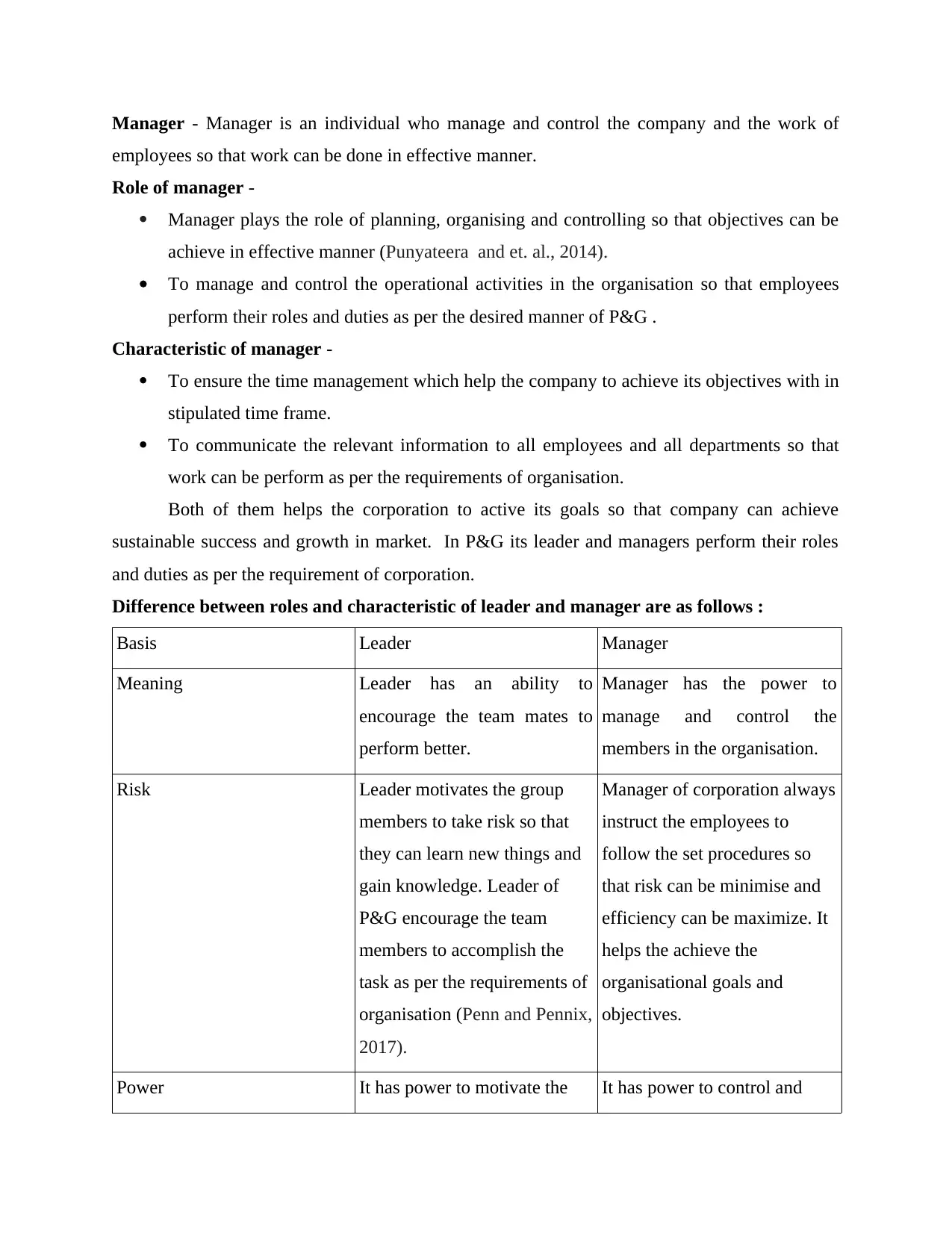
Manager - Manager is an individual who manage and control the company and the work of
employees so that work can be done in effective manner.
Role of manager -
Manager plays the role of planning, organising and controlling so that objectives can be
achieve in effective manner (Punyateera and et. al., 2014).
To manage and control the operational activities in the organisation so that employees
perform their roles and duties as per the desired manner of P&G .
Characteristic of manager -
To ensure the time management which help the company to achieve its objectives with in
stipulated time frame.
To communicate the relevant information to all employees and all departments so that
work can be perform as per the requirements of organisation.
Both of them helps the corporation to active its goals so that company can achieve
sustainable success and growth in market. In P&G its leader and managers perform their roles
and duties as per the requirement of corporation.
Difference between roles and characteristic of leader and manager are as follows :
Basis Leader Manager
Meaning Leader has an ability to
encourage the team mates to
perform better.
Manager has the power to
manage and control the
members in the organisation.
Risk Leader motivates the group
members to take risk so that
they can learn new things and
gain knowledge. Leader of
P&G encourage the team
members to accomplish the
task as per the requirements of
organisation (Penn and Pennix,
2017).
Manager of corporation always
instruct the employees to
follow the set procedures so
that risk can be minimise and
efficiency can be maximize. It
helps the achieve the
organisational goals and
objectives.
Power It has power to motivate the It has power to control and
employees so that work can be done in effective manner.
Role of manager -
Manager plays the role of planning, organising and controlling so that objectives can be
achieve in effective manner (Punyateera and et. al., 2014).
To manage and control the operational activities in the organisation so that employees
perform their roles and duties as per the desired manner of P&G .
Characteristic of manager -
To ensure the time management which help the company to achieve its objectives with in
stipulated time frame.
To communicate the relevant information to all employees and all departments so that
work can be perform as per the requirements of organisation.
Both of them helps the corporation to active its goals so that company can achieve
sustainable success and growth in market. In P&G its leader and managers perform their roles
and duties as per the requirement of corporation.
Difference between roles and characteristic of leader and manager are as follows :
Basis Leader Manager
Meaning Leader has an ability to
encourage the team mates to
perform better.
Manager has the power to
manage and control the
members in the organisation.
Risk Leader motivates the group
members to take risk so that
they can learn new things and
gain knowledge. Leader of
P&G encourage the team
members to accomplish the
task as per the requirements of
organisation (Penn and Pennix,
2017).
Manager of corporation always
instruct the employees to
follow the set procedures so
that risk can be minimise and
efficiency can be maximize. It
helps the achieve the
organisational goals and
objectives.
Power It has power to motivate the It has power to control and
Paraphrase This Document
Need a fresh take? Get an instant paraphrase of this document with our AI Paraphraser
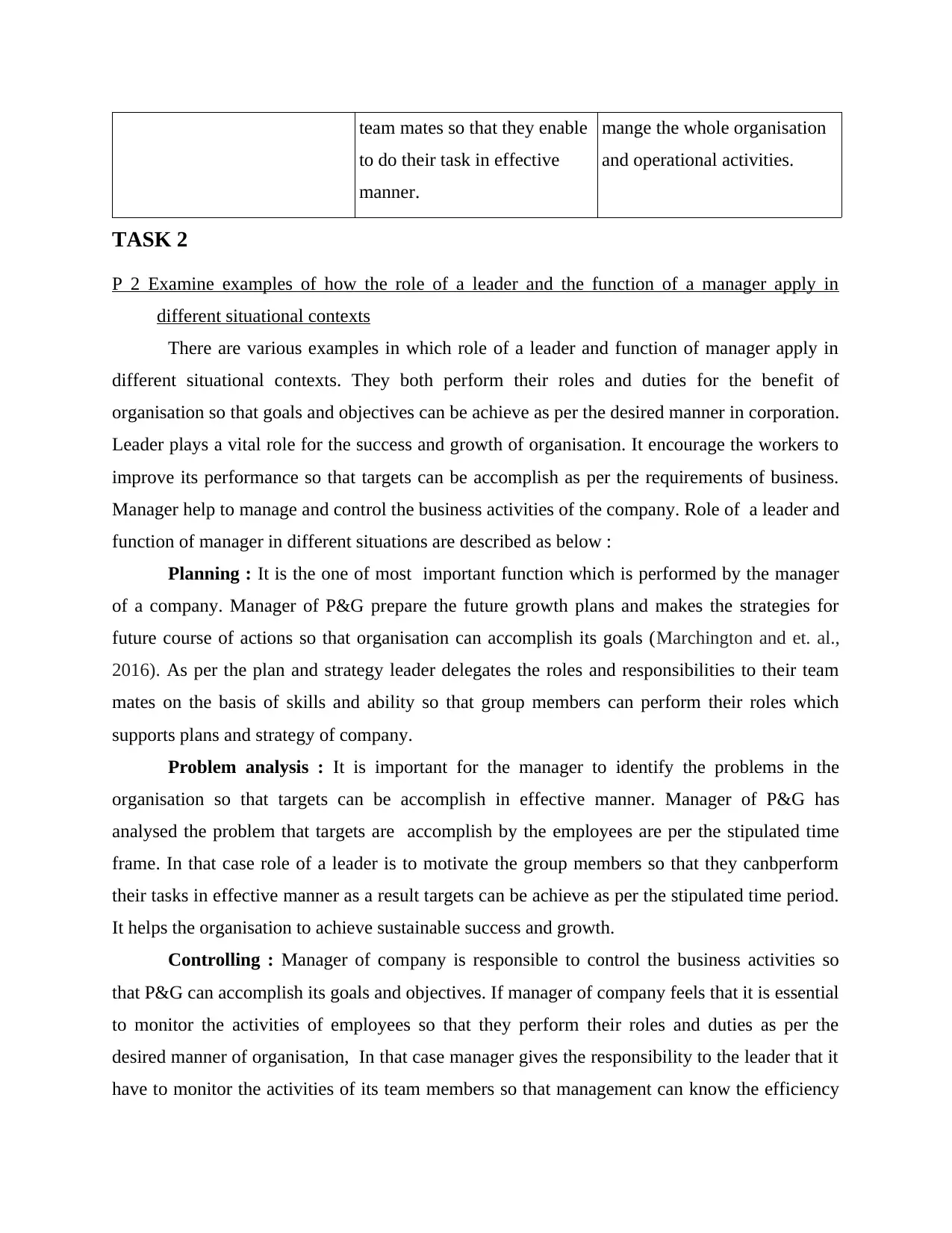
team mates so that they enable
to do their task in effective
manner.
mange the whole organisation
and operational activities.
TASK 2
P 2 Examine examples of how the role of a leader and the function of a manager apply in
different situational contexts
There are various examples in which role of a leader and function of manager apply in
different situational contexts. They both perform their roles and duties for the benefit of
organisation so that goals and objectives can be achieve as per the desired manner in corporation.
Leader plays a vital role for the success and growth of organisation. It encourage the workers to
improve its performance so that targets can be accomplish as per the requirements of business.
Manager help to manage and control the business activities of the company. Role of a leader and
function of manager in different situations are described as below :
Planning : It is the one of most important function which is performed by the manager
of a company. Manager of P&G prepare the future growth plans and makes the strategies for
future course of actions so that organisation can accomplish its goals (Marchington and et. al.,
2016). As per the plan and strategy leader delegates the roles and responsibilities to their team
mates on the basis of skills and ability so that group members can perform their roles which
supports plans and strategy of company.
Problem analysis : It is important for the manager to identify the problems in the
organisation so that targets can be accomplish in effective manner. Manager of P&G has
analysed the problem that targets are accomplish by the employees are per the stipulated time
frame. In that case role of a leader is to motivate the group members so that they canbperform
their tasks in effective manner as a result targets can be achieve as per the stipulated time period.
It helps the organisation to achieve sustainable success and growth.
Controlling : Manager of company is responsible to control the business activities so
that P&G can accomplish its goals and objectives. If manager of company feels that it is essential
to monitor the activities of employees so that they perform their roles and duties as per the
desired manner of organisation, In that case manager gives the responsibility to the leader that it
have to monitor the activities of its team members so that management can know the efficiency
to do their task in effective
manner.
mange the whole organisation
and operational activities.
TASK 2
P 2 Examine examples of how the role of a leader and the function of a manager apply in
different situational contexts
There are various examples in which role of a leader and function of manager apply in
different situational contexts. They both perform their roles and duties for the benefit of
organisation so that goals and objectives can be achieve as per the desired manner in corporation.
Leader plays a vital role for the success and growth of organisation. It encourage the workers to
improve its performance so that targets can be accomplish as per the requirements of business.
Manager help to manage and control the business activities of the company. Role of a leader and
function of manager in different situations are described as below :
Planning : It is the one of most important function which is performed by the manager
of a company. Manager of P&G prepare the future growth plans and makes the strategies for
future course of actions so that organisation can accomplish its goals (Marchington and et. al.,
2016). As per the plan and strategy leader delegates the roles and responsibilities to their team
mates on the basis of skills and ability so that group members can perform their roles which
supports plans and strategy of company.
Problem analysis : It is important for the manager to identify the problems in the
organisation so that targets can be accomplish in effective manner. Manager of P&G has
analysed the problem that targets are accomplish by the employees are per the stipulated time
frame. In that case role of a leader is to motivate the group members so that they canbperform
their tasks in effective manner as a result targets can be achieve as per the stipulated time period.
It helps the organisation to achieve sustainable success and growth.
Controlling : Manager of company is responsible to control the business activities so
that P&G can accomplish its goals and objectives. If manager of company feels that it is essential
to monitor the activities of employees so that they perform their roles and duties as per the
desired manner of organisation, In that case manager gives the responsibility to the leader that it
have to monitor the activities of its team members so that management can know the efficiency
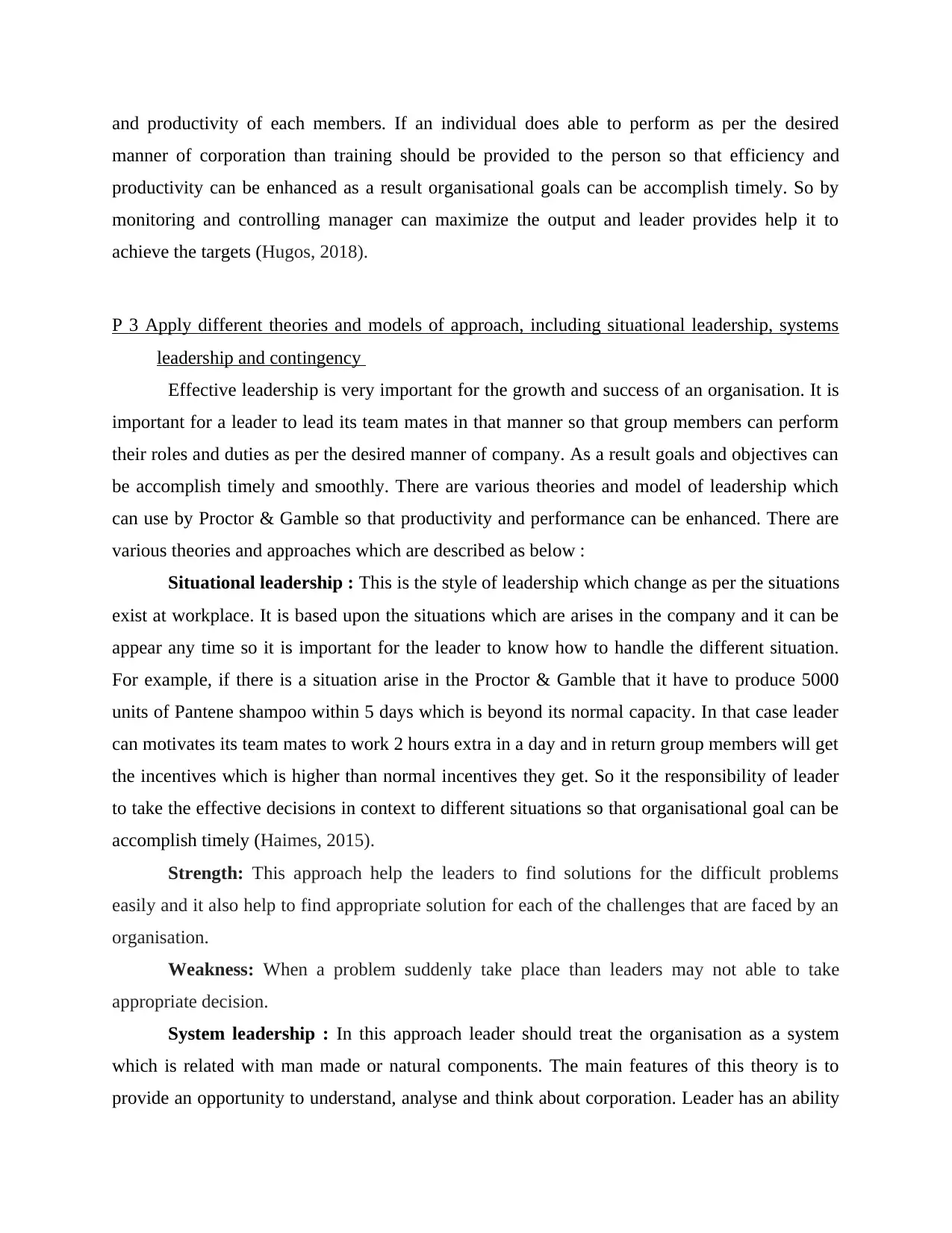
and productivity of each members. If an individual does able to perform as per the desired
manner of corporation than training should be provided to the person so that efficiency and
productivity can be enhanced as a result organisational goals can be accomplish timely. So by
monitoring and controlling manager can maximize the output and leader provides help it to
achieve the targets (Hugos, 2018).
P 3 Apply different theories and models of approach, including situational leadership, systems
leadership and contingency
Effective leadership is very important for the growth and success of an organisation. It is
important for a leader to lead its team mates in that manner so that group members can perform
their roles and duties as per the desired manner of company. As a result goals and objectives can
be accomplish timely and smoothly. There are various theories and model of leadership which
can use by Proctor & Gamble so that productivity and performance can be enhanced. There are
various theories and approaches which are described as below :
Situational leadership : This is the style of leadership which change as per the situations
exist at workplace. It is based upon the situations which are arises in the company and it can be
appear any time so it is important for the leader to know how to handle the different situation.
For example, if there is a situation arise in the Proctor & Gamble that it have to produce 5000
units of Pantene shampoo within 5 days which is beyond its normal capacity. In that case leader
can motivates its team mates to work 2 hours extra in a day and in return group members will get
the incentives which is higher than normal incentives they get. So it the responsibility of leader
to take the effective decisions in context to different situations so that organisational goal can be
accomplish timely (Haimes, 2015).
Strength: This approach help the leaders to find solutions for the difficult problems
easily and it also help to find appropriate solution for each of the challenges that are faced by an
organisation.
Weakness: When a problem suddenly take place than leaders may not able to take
appropriate decision.
System leadership : In this approach leader should treat the organisation as a system
which is related with man made or natural components. The main features of this theory is to
provide an opportunity to understand, analyse and think about corporation. Leader has an ability
manner of corporation than training should be provided to the person so that efficiency and
productivity can be enhanced as a result organisational goals can be accomplish timely. So by
monitoring and controlling manager can maximize the output and leader provides help it to
achieve the targets (Hugos, 2018).
P 3 Apply different theories and models of approach, including situational leadership, systems
leadership and contingency
Effective leadership is very important for the growth and success of an organisation. It is
important for a leader to lead its team mates in that manner so that group members can perform
their roles and duties as per the desired manner of company. As a result goals and objectives can
be accomplish timely and smoothly. There are various theories and model of leadership which
can use by Proctor & Gamble so that productivity and performance can be enhanced. There are
various theories and approaches which are described as below :
Situational leadership : This is the style of leadership which change as per the situations
exist at workplace. It is based upon the situations which are arises in the company and it can be
appear any time so it is important for the leader to know how to handle the different situation.
For example, if there is a situation arise in the Proctor & Gamble that it have to produce 5000
units of Pantene shampoo within 5 days which is beyond its normal capacity. In that case leader
can motivates its team mates to work 2 hours extra in a day and in return group members will get
the incentives which is higher than normal incentives they get. So it the responsibility of leader
to take the effective decisions in context to different situations so that organisational goal can be
accomplish timely (Haimes, 2015).
Strength: This approach help the leaders to find solutions for the difficult problems
easily and it also help to find appropriate solution for each of the challenges that are faced by an
organisation.
Weakness: When a problem suddenly take place than leaders may not able to take
appropriate decision.
System leadership : In this approach leader should treat the organisation as a system
which is related with man made or natural components. The main features of this theory is to
provide an opportunity to understand, analyse and think about corporation. Leader has an ability
⊘ This is a preview!⊘
Do you want full access?
Subscribe today to unlock all pages.

Trusted by 1+ million students worldwide
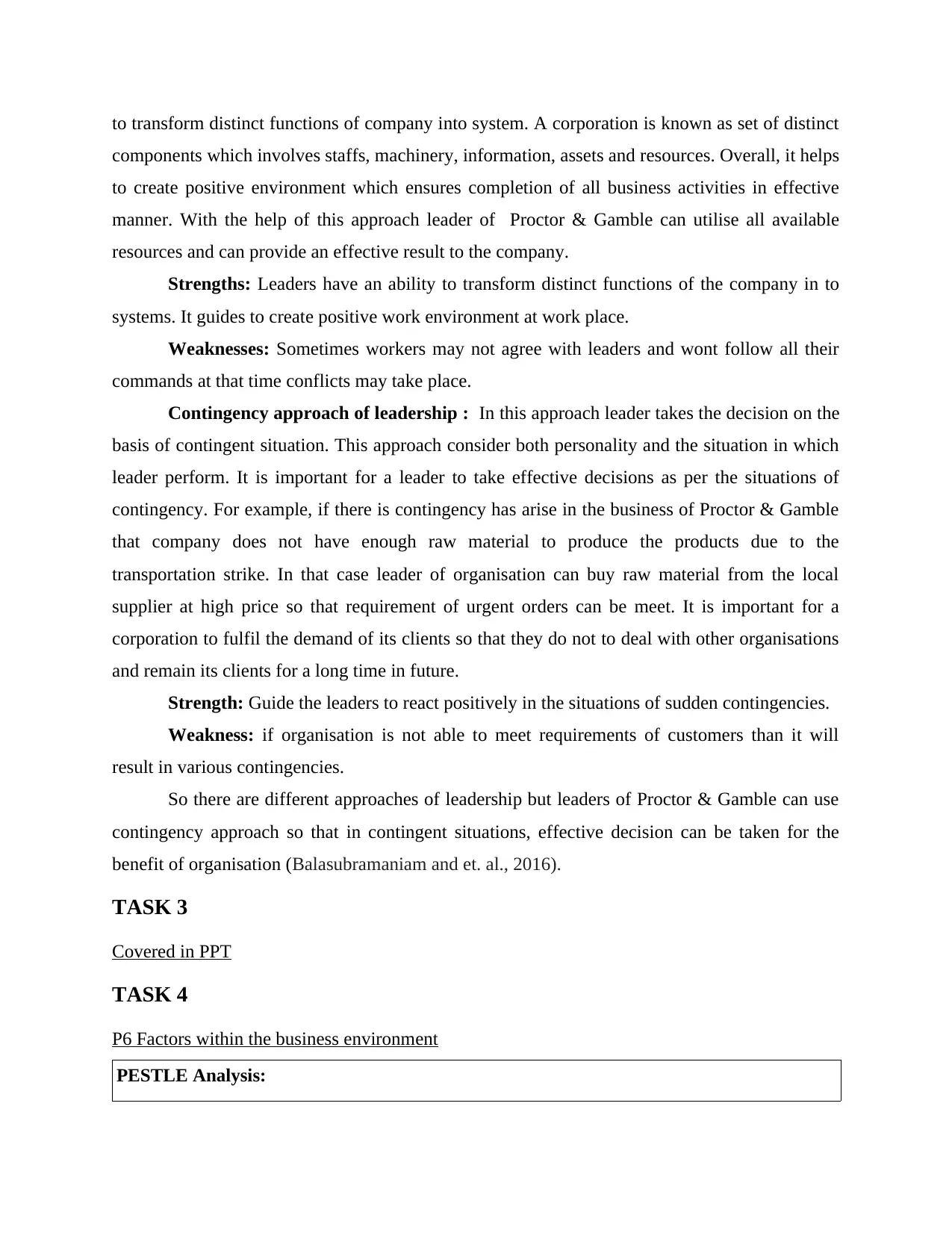
to transform distinct functions of company into system. A corporation is known as set of distinct
components which involves staffs, machinery, information, assets and resources. Overall, it helps
to create positive environment which ensures completion of all business activities in effective
manner. With the help of this approach leader of Proctor & Gamble can utilise all available
resources and can provide an effective result to the company.
Strengths: Leaders have an ability to transform distinct functions of the company in to
systems. It guides to create positive work environment at work place.
Weaknesses: Sometimes workers may not agree with leaders and wont follow all their
commands at that time conflicts may take place.
Contingency approach of leadership : In this approach leader takes the decision on the
basis of contingent situation. This approach consider both personality and the situation in which
leader perform. It is important for a leader to take effective decisions as per the situations of
contingency. For example, if there is contingency has arise in the business of Proctor & Gamble
that company does not have enough raw material to produce the products due to the
transportation strike. In that case leader of organisation can buy raw material from the local
supplier at high price so that requirement of urgent orders can be meet. It is important for a
corporation to fulfil the demand of its clients so that they do not to deal with other organisations
and remain its clients for a long time in future.
Strength: Guide the leaders to react positively in the situations of sudden contingencies.
Weakness: if organisation is not able to meet requirements of customers than it will
result in various contingencies.
So there are different approaches of leadership but leaders of Proctor & Gamble can use
contingency approach so that in contingent situations, effective decision can be taken for the
benefit of organisation (Balasubramaniam and et. al., 2016).
TASK 3
Covered in PPT
TASK 4
P6 Factors within the business environment
PESTLE Analysis:
components which involves staffs, machinery, information, assets and resources. Overall, it helps
to create positive environment which ensures completion of all business activities in effective
manner. With the help of this approach leader of Proctor & Gamble can utilise all available
resources and can provide an effective result to the company.
Strengths: Leaders have an ability to transform distinct functions of the company in to
systems. It guides to create positive work environment at work place.
Weaknesses: Sometimes workers may not agree with leaders and wont follow all their
commands at that time conflicts may take place.
Contingency approach of leadership : In this approach leader takes the decision on the
basis of contingent situation. This approach consider both personality and the situation in which
leader perform. It is important for a leader to take effective decisions as per the situations of
contingency. For example, if there is contingency has arise in the business of Proctor & Gamble
that company does not have enough raw material to produce the products due to the
transportation strike. In that case leader of organisation can buy raw material from the local
supplier at high price so that requirement of urgent orders can be meet. It is important for a
corporation to fulfil the demand of its clients so that they do not to deal with other organisations
and remain its clients for a long time in future.
Strength: Guide the leaders to react positively in the situations of sudden contingencies.
Weakness: if organisation is not able to meet requirements of customers than it will
result in various contingencies.
So there are different approaches of leadership but leaders of Proctor & Gamble can use
contingency approach so that in contingent situations, effective decision can be taken for the
benefit of organisation (Balasubramaniam and et. al., 2016).
TASK 3
Covered in PPT
TASK 4
P6 Factors within the business environment
PESTLE Analysis:
Paraphrase This Document
Need a fresh take? Get an instant paraphrase of this document with our AI Paraphraser
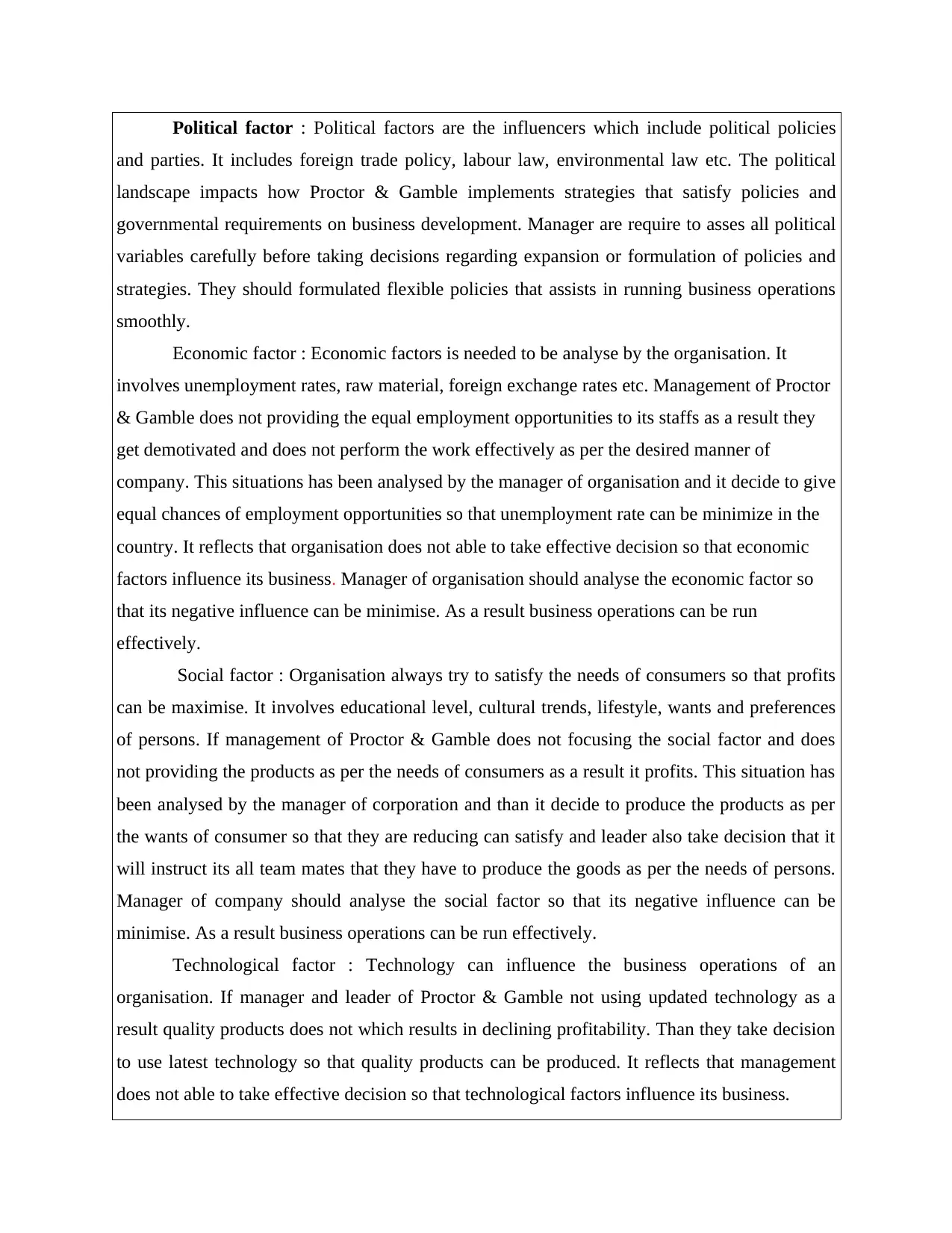
Political factor : Political factors are the influencers which include political policies
and parties. It includes foreign trade policy, labour law, environmental law etc. The political
landscape impacts how Proctor & Gamble implements strategies that satisfy policies and
governmental requirements on business development. Manager are require to asses all political
variables carefully before taking decisions regarding expansion or formulation of policies and
strategies. They should formulated flexible policies that assists in running business operations
smoothly.
Economic factor : Economic factors is needed to be analyse by the organisation. It
involves unemployment rates, raw material, foreign exchange rates etc. Management of Proctor
& Gamble does not providing the equal employment opportunities to its staffs as a result they
get demotivated and does not perform the work effectively as per the desired manner of
company. This situations has been analysed by the manager of organisation and it decide to give
equal chances of employment opportunities so that unemployment rate can be minimize in the
country. It reflects that organisation does not able to take effective decision so that economic
factors influence its business. Manager of organisation should analyse the economic factor so
that its negative influence can be minimise. As a result business operations can be run
effectively.
Social factor : Organisation always try to satisfy the needs of consumers so that profits
can be maximise. It involves educational level, cultural trends, lifestyle, wants and preferences
of persons. If management of Proctor & Gamble does not focusing the social factor and does
not providing the products as per the needs of consumers as a result it profits. This situation has
been analysed by the manager of corporation and than it decide to produce the products as per
the wants of consumer so that they are reducing can satisfy and leader also take decision that it
will instruct its all team mates that they have to produce the goods as per the needs of persons.
Manager of company should analyse the social factor so that its negative influence can be
minimise. As a result business operations can be run effectively.
Technological factor : Technology can influence the business operations of an
organisation. If manager and leader of Proctor & Gamble not using updated technology as a
result quality products does not which results in declining profitability. Than they take decision
to use latest technology so that quality products can be produced. It reflects that management
does not able to take effective decision so that technological factors influence its business.
and parties. It includes foreign trade policy, labour law, environmental law etc. The political
landscape impacts how Proctor & Gamble implements strategies that satisfy policies and
governmental requirements on business development. Manager are require to asses all political
variables carefully before taking decisions regarding expansion or formulation of policies and
strategies. They should formulated flexible policies that assists in running business operations
smoothly.
Economic factor : Economic factors is needed to be analyse by the organisation. It
involves unemployment rates, raw material, foreign exchange rates etc. Management of Proctor
& Gamble does not providing the equal employment opportunities to its staffs as a result they
get demotivated and does not perform the work effectively as per the desired manner of
company. This situations has been analysed by the manager of organisation and it decide to give
equal chances of employment opportunities so that unemployment rate can be minimize in the
country. It reflects that organisation does not able to take effective decision so that economic
factors influence its business. Manager of organisation should analyse the economic factor so
that its negative influence can be minimise. As a result business operations can be run
effectively.
Social factor : Organisation always try to satisfy the needs of consumers so that profits
can be maximise. It involves educational level, cultural trends, lifestyle, wants and preferences
of persons. If management of Proctor & Gamble does not focusing the social factor and does
not providing the products as per the needs of consumers as a result it profits. This situation has
been analysed by the manager of corporation and than it decide to produce the products as per
the wants of consumer so that they are reducing can satisfy and leader also take decision that it
will instruct its all team mates that they have to produce the goods as per the needs of persons.
Manager of company should analyse the social factor so that its negative influence can be
minimise. As a result business operations can be run effectively.
Technological factor : Technology can influence the business operations of an
organisation. If manager and leader of Proctor & Gamble not using updated technology as a
result quality products does not which results in declining profitability. Than they take decision
to use latest technology so that quality products can be produced. It reflects that management
does not able to take effective decision so that technological factors influence its business.
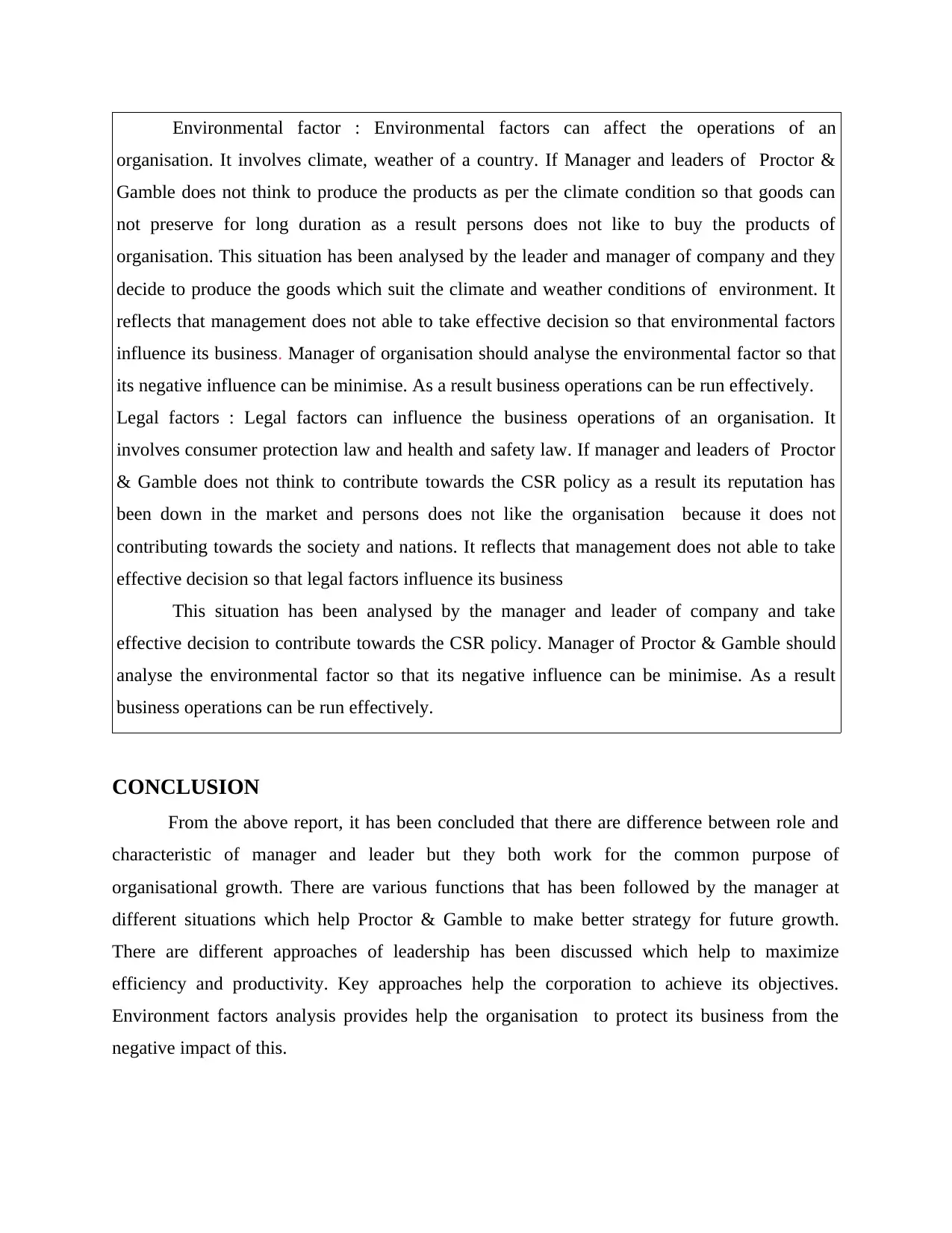
Environmental factor : Environmental factors can affect the operations of an
organisation. It involves climate, weather of a country. If Manager and leaders of Proctor &
Gamble does not think to produce the products as per the climate condition so that goods can
not preserve for long duration as a result persons does not like to buy the products of
organisation. This situation has been analysed by the leader and manager of company and they
decide to produce the goods which suit the climate and weather conditions of environment. It
reflects that management does not able to take effective decision so that environmental factors
influence its business. Manager of organisation should analyse the environmental factor so that
its negative influence can be minimise. As a result business operations can be run effectively.
Legal factors : Legal factors can influence the business operations of an organisation. It
involves consumer protection law and health and safety law. If manager and leaders of Proctor
& Gamble does not think to contribute towards the CSR policy as a result its reputation has
been down in the market and persons does not like the organisation because it does not
contributing towards the society and nations. It reflects that management does not able to take
effective decision so that legal factors influence its business
This situation has been analysed by the manager and leader of company and take
effective decision to contribute towards the CSR policy. Manager of Proctor & Gamble should
analyse the environmental factor so that its negative influence can be minimise. As a result
business operations can be run effectively.
CONCLUSION
From the above report, it has been concluded that there are difference between role and
characteristic of manager and leader but they both work for the common purpose of
organisational growth. There are various functions that has been followed by the manager at
different situations which help Proctor & Gamble to make better strategy for future growth.
There are different approaches of leadership has been discussed which help to maximize
efficiency and productivity. Key approaches help the corporation to achieve its objectives.
Environment factors analysis provides help the organisation to protect its business from the
negative impact of this.
organisation. It involves climate, weather of a country. If Manager and leaders of Proctor &
Gamble does not think to produce the products as per the climate condition so that goods can
not preserve for long duration as a result persons does not like to buy the products of
organisation. This situation has been analysed by the leader and manager of company and they
decide to produce the goods which suit the climate and weather conditions of environment. It
reflects that management does not able to take effective decision so that environmental factors
influence its business. Manager of organisation should analyse the environmental factor so that
its negative influence can be minimise. As a result business operations can be run effectively.
Legal factors : Legal factors can influence the business operations of an organisation. It
involves consumer protection law and health and safety law. If manager and leaders of Proctor
& Gamble does not think to contribute towards the CSR policy as a result its reputation has
been down in the market and persons does not like the organisation because it does not
contributing towards the society and nations. It reflects that management does not able to take
effective decision so that legal factors influence its business
This situation has been analysed by the manager and leader of company and take
effective decision to contribute towards the CSR policy. Manager of Proctor & Gamble should
analyse the environmental factor so that its negative influence can be minimise. As a result
business operations can be run effectively.
CONCLUSION
From the above report, it has been concluded that there are difference between role and
characteristic of manager and leader but they both work for the common purpose of
organisational growth. There are various functions that has been followed by the manager at
different situations which help Proctor & Gamble to make better strategy for future growth.
There are different approaches of leadership has been discussed which help to maximize
efficiency and productivity. Key approaches help the corporation to achieve its objectives.
Environment factors analysis provides help the organisation to protect its business from the
negative impact of this.
⊘ This is a preview!⊘
Do you want full access?
Subscribe today to unlock all pages.

Trusted by 1+ million students worldwide
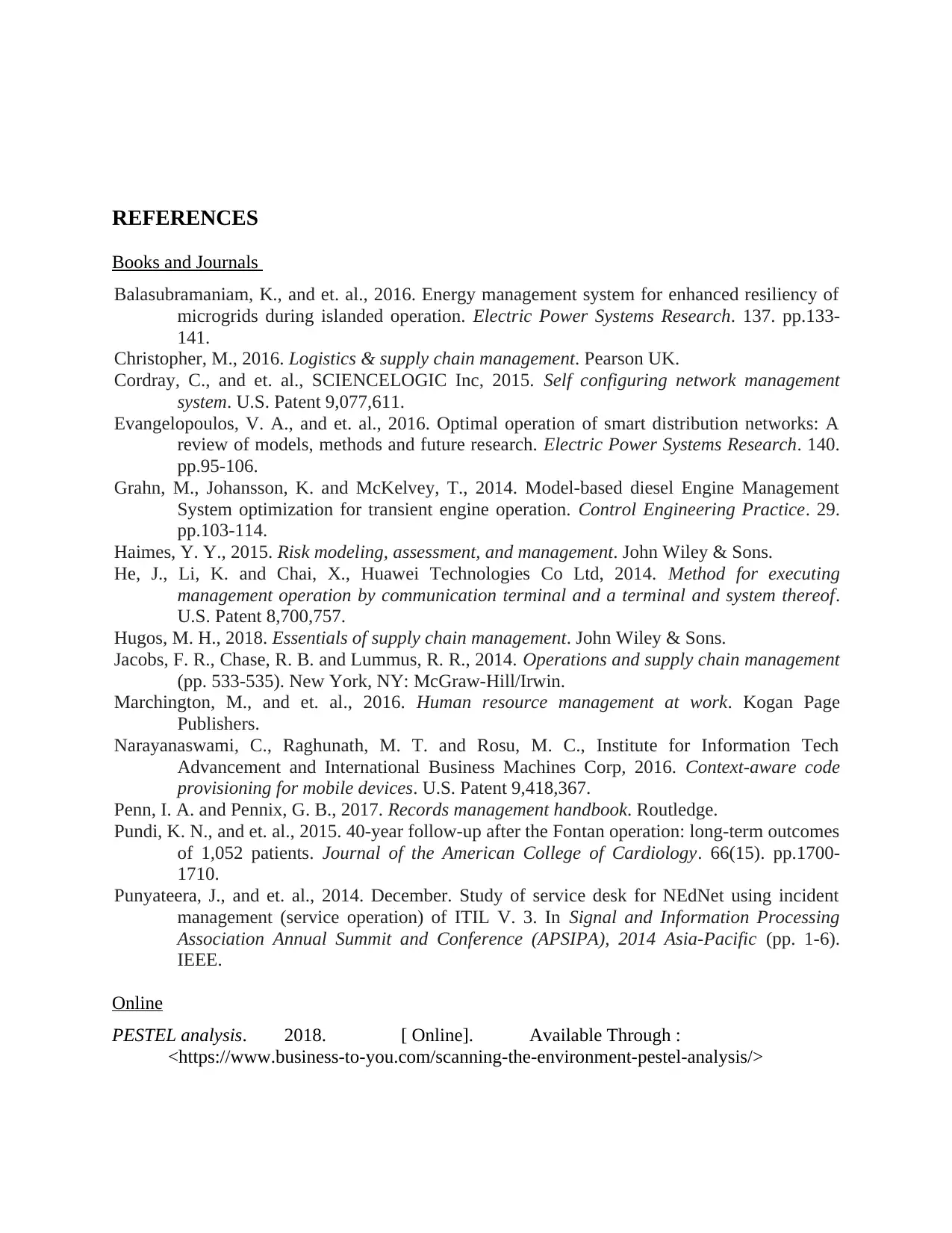
REFERENCES
Books and Journals
Balasubramaniam, K., and et. al., 2016. Energy management system for enhanced resiliency of
microgrids during islanded operation. Electric Power Systems Research. 137. pp.133-
141.
Christopher, M., 2016. Logistics & supply chain management. Pearson UK.
Cordray, C., and et. al., SCIENCELOGIC Inc, 2015. Self configuring network management
system. U.S. Patent 9,077,611.
Evangelopoulos, V. A., and et. al., 2016. Optimal operation of smart distribution networks: A
review of models, methods and future research. Electric Power Systems Research. 140.
pp.95-106.
Grahn, M., Johansson, K. and McKelvey, T., 2014. Model-based diesel Engine Management
System optimization for transient engine operation. Control Engineering Practice. 29.
pp.103-114.
Haimes, Y. Y., 2015. Risk modeling, assessment, and management. John Wiley & Sons.
He, J., Li, K. and Chai, X., Huawei Technologies Co Ltd, 2014. Method for executing
management operation by communication terminal and a terminal and system thereof.
U.S. Patent 8,700,757.
Hugos, M. H., 2018. Essentials of supply chain management. John Wiley & Sons.
Jacobs, F. R., Chase, R. B. and Lummus, R. R., 2014. Operations and supply chain management
(pp. 533-535). New York, NY: McGraw-Hill/Irwin.
Marchington, M., and et. al., 2016. Human resource management at work. Kogan Page
Publishers.
Narayanaswami, C., Raghunath, M. T. and Rosu, M. C., Institute for Information Tech
Advancement and International Business Machines Corp, 2016. Context-aware code
provisioning for mobile devices. U.S. Patent 9,418,367.
Penn, I. A. and Pennix, G. B., 2017. Records management handbook. Routledge.
Pundi, K. N., and et. al., 2015. 40-year follow-up after the Fontan operation: long-term outcomes
of 1,052 patients. Journal of the American College of Cardiology. 66(15). pp.1700-
1710.
Punyateera, J., and et. al., 2014. December. Study of service desk for NEdNet using incident
management (service operation) of ITIL V. 3. In Signal and Information Processing
Association Annual Summit and Conference (APSIPA), 2014 Asia-Pacific (pp. 1-6).
IEEE.
Online
PESTEL analysis. 2018. [ Online]. Available Through :
<https://www.business-to-you.com/scanning-the-environment-pestel-analysis/>
Books and Journals
Balasubramaniam, K., and et. al., 2016. Energy management system for enhanced resiliency of
microgrids during islanded operation. Electric Power Systems Research. 137. pp.133-
141.
Christopher, M., 2016. Logistics & supply chain management. Pearson UK.
Cordray, C., and et. al., SCIENCELOGIC Inc, 2015. Self configuring network management
system. U.S. Patent 9,077,611.
Evangelopoulos, V. A., and et. al., 2016. Optimal operation of smart distribution networks: A
review of models, methods and future research. Electric Power Systems Research. 140.
pp.95-106.
Grahn, M., Johansson, K. and McKelvey, T., 2014. Model-based diesel Engine Management
System optimization for transient engine operation. Control Engineering Practice. 29.
pp.103-114.
Haimes, Y. Y., 2015. Risk modeling, assessment, and management. John Wiley & Sons.
He, J., Li, K. and Chai, X., Huawei Technologies Co Ltd, 2014. Method for executing
management operation by communication terminal and a terminal and system thereof.
U.S. Patent 8,700,757.
Hugos, M. H., 2018. Essentials of supply chain management. John Wiley & Sons.
Jacobs, F. R., Chase, R. B. and Lummus, R. R., 2014. Operations and supply chain management
(pp. 533-535). New York, NY: McGraw-Hill/Irwin.
Marchington, M., and et. al., 2016. Human resource management at work. Kogan Page
Publishers.
Narayanaswami, C., Raghunath, M. T. and Rosu, M. C., Institute for Information Tech
Advancement and International Business Machines Corp, 2016. Context-aware code
provisioning for mobile devices. U.S. Patent 9,418,367.
Penn, I. A. and Pennix, G. B., 2017. Records management handbook. Routledge.
Pundi, K. N., and et. al., 2015. 40-year follow-up after the Fontan operation: long-term outcomes
of 1,052 patients. Journal of the American College of Cardiology. 66(15). pp.1700-
1710.
Punyateera, J., and et. al., 2014. December. Study of service desk for NEdNet using incident
management (service operation) of ITIL V. 3. In Signal and Information Processing
Association Annual Summit and Conference (APSIPA), 2014 Asia-Pacific (pp. 1-6).
IEEE.
Online
PESTEL analysis. 2018. [ Online]. Available Through :
<https://www.business-to-you.com/scanning-the-environment-pestel-analysis/>
Paraphrase This Document
Need a fresh take? Get an instant paraphrase of this document with our AI Paraphraser

1 out of 11
Related Documents
Your All-in-One AI-Powered Toolkit for Academic Success.
+13062052269
info@desklib.com
Available 24*7 on WhatsApp / Email
![[object Object]](/_next/static/media/star-bottom.7253800d.svg)
Unlock your academic potential
Copyright © 2020–2025 A2Z Services. All Rights Reserved. Developed and managed by ZUCOL.




